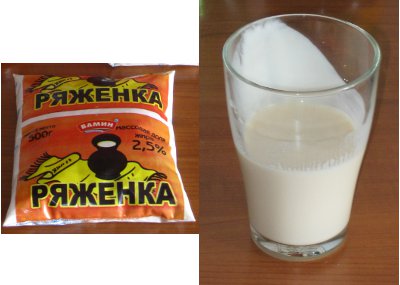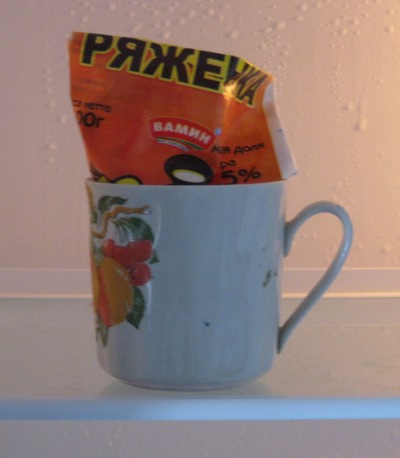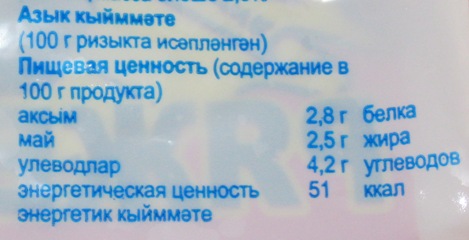Ряженка
The Russians drink a variety of fermented milk products and one of them is ряженка. You take milk, mix it with a bacterial culture, let it ferment for six to eight hours, then bring the process to a close. Essentially it is a type of yogurt without any flavor additives. Compared to кефир kefir, it's flavor is less acidic. We have no special word for this in English, so we usually just transliterate it as ryazhenka. It declines like this:
| Sg | |
| Nom | ряженка |
| Acc | ряженку |
| Gen | ряженки |
| Pre | ряженке |
| Dat | |
| Ins | ряженкой |
This last week I bought a packet of ряженка at the store. That's right: in Russia cold liquids are often sold in plastic packets. Here you can see it on the left. I drink about half a packet at a time, pouring it into a glass, which you can see on the left:

Now a thoughtful homemaker will wonder, “If it is in a floppy plastic bag, how the heck am I supposed to store an opened packet in the fridge?” Why, you stand the packet up in a mug, of course!

Let's see the word in some sentences:
| — Где тут можно купить ряженку? — За углом, в «Пятёрочке». |
“Where can I buy ryazhenka?” “Around the corner at the Pyatyorochka [store].” |
| Ряженка — кисломолочный напиток, получаемый из коровьего топлёного молока молочнокислым брожением. (source) | Ryazhenka is a fermented milk product made from heated cow's milk by lactic (acid) fermentation. |
| Ненавижу Америку. Там нет ряженки. А что я должна пить на завтрак? ¹ | I hate America. There's no ryazhenka there. So what am I supposed to drink for breakfast? |
| Я обожаю холодный ягодный суп с ряженкой. (recipe) | I adore cold berry soup with ryazhenka. |
Since I'm trying to limit my carb intake this summer, I of course am now wondering what the carb load is. Here's the ingredient lable. The words that appear first are in Tatar, since I am living in Kazan, and the words that follow are in Russian:

They mean:
| Nutritional value | (per 100 g) |
| Protein | 2.8 g |
| Fat | 2.5 g |
| Carbohydrates | 4.2 g |
| Calories ² | 51 |
Hm. Let's see. 100 mg of ryazhenka has 4.1 g of carbs. I'm limiting myself to 20 g of carbs a day. If a glass is 250 mg, then that's roughly 10 g of carbs for a glass of ryazhenka. Damn. That's half the day's carbs right there. Guess that means that leaves only meat and fat for the rest of the day. Actually, I can live with that.
¹ This was actually said by a Russian woman visiting the US. We had no kefir, no ryazhenka, no tvorog. It was like there was no human food there at all!
² Note to Russian readers: in the US when listing nutritional information, the word "calorie" means "kilocalorie". So for a nutritional discussion, "calorie" is a proper translation for ккал, even though in the metric system that is properly translated kilocalorie.
8 comments
> ‘m studying abroad in Russia for the summer and I have a question
> about tvorog. I’ve always seen it translated as ‘cottage cheese’,
> but I hate cottage cheese and love tvorog. Do you know how close it
> is to ‘farmer’s cheese’?
In Germany they call it “quark” and I’ve actually seen quark being
sold in the US (at New Seasons Market in Portland, OR) and in
Vancouver, Canada. However, it was nothing like real tvorog, it was a
thick liquid which tasted a bit bitter.
You can make tvorog yourself pretty easily. Just heat up some yogurt
to about 200F, until it curdles. You’ll see greenish-yellow whey
separate, with white curds floating in it. Don’t mix it up unless or
you want to end up with very fine-grained tvorog. Cool this mixture
down, put some cheese cloth in a strainer (several layers if the
cheese cloth is not fine-mesh), pour the mixture in and let the whey
drain out, for a couple hours or longer. That’s all.
You can discard whey, but it’s very good for you so just drink it. It
doesn’t taste that great but it has a ton of minerals. It’s really
good at restoring mineral balance after sweating at a workout. Also,
whey is fantastic when used for bread or pizza dough in place of
water–try it!
If you make your own yogurt, tvorog will turn out considerably cheaper
(2-3 times) than when using store-bought yogurt.
> You take milk, mix it with a bacterial culture, let it ferment for
> six to eight hours, then bring the process to a close.
This will get you good old yogurt, not ряженка. If you want to make
ряженка, you’ll need to use “baked milk” instead of regular milk. To
make baked milk, either simmer milk for 2-3 hours on low heat until it
turns light beige, or bake milk in an open jar/pot in the oven at
350F, again until it turns light beige (might be longer than 3 hours).
The milk can form a brownish crust on top, that’s normal, the crust is
edible.
When the baked milk is done, cool it to about 110F (that’s when it
feels very warm but not hot), add 2-3 Tbsp of yogurt or sour cream,
mix it all up well, place the jar/pot in a warm place and cover with a
towel. Ряженка will be ready in 6-8 hours.
Don adds: Thanks, Oleg! For American readers I should add that you want live culture yogurt and sour cream, not the typical stuff you find in an American store. Those yogurts and sour creams have a good chance of having very little active culture remaining in them.
Nice to see the Вамин production on your blog :-)
Btw, have you tried other ряженка brands, like Для всей семьи or Простоквашино? They have better taste in my opinion.
Hey, hello and just one question, proly someone asked it before but I did not follow this blog back bafore - WHY do you provide, in declination, cases in this order: nom/acc/gen/pre/dat/ins? In slavic languages, it is mostly taught this way: nom/gen/dat/acc/ins/pre or loc(ativus). I am Polish and all Polish kids are taught this way, from what I know, other Slavic language speakers as well. Hmm. Just curious (maybe in Russia it is different, I ain’t no fluent Russian speaker or never was in any elementary Russian school, sorry). I am also alsking, becauses the order you provde is really strange (at least for all Poles), and I think the one I suggest - would make no difference to Westeners (since the very idea of cases is hard for them , anyway) :) best regards, H.
Don responds: for a comparison of the two systems for presenting case, see this page. The short version of my answer is this: the textbook/dictionary order used in most Slavic countries does not display the syncretism of case forms as well as the linguistic order does. I myself was trained under the old system and have taught both the old and new systems. The new system is superior for presenting case endings to foreigners. It is pedagogically better and more logical. It would be pedagogically superior in the Slavic countries as well, but it continues to be used there due to simple inertia.
I’m studying abroad in Russia for the summer and I have a question about tvorog. I’ve always seen it translated as ‘cottage cheese’, but I hate cottage cheese and love tvorog. Do you know how close it is to ‘farmer’s cheese’?
Don responds: I’ve actually never bought farmer’s cheese in the US, but Russians who have moved to the States tell me it the closest equivalent we have to творог.
Just went down to the продукты near the apartment I’m staying at this summer and bought a packet of ряженка. Looking forward to trying it out at breakfast tomorrow.
On the calories note, I believe the US version is capitalized (Calories) to indicate kcal. It takes some adjusting when you go to almost any other country and initially marvel at the number of [what you think are] calories they pack into their groceries. That seems to only the case with food… in thermodynamics energy would be measured in kcal - at least, I don’t recall ever seeing capital Calories to indicate 1000 cal in that context.
(On a semi-related note, one of the words in my Captcha image is “Food.")
I think the little 2 should be behind Calories, not Carbohydrates.
Don responds: Thanks! Fixed.
Form is loading...